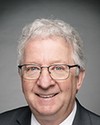Okay.
Was there a pilot on board when the ship entered, and if so, is the pilot not in charge of the ship in terms of bringing the ship into the harbour?
Evidence of meeting #13 for Fisheries and Oceans in the 44th Parliament, 1st Session. (The original version is on Parliament’s site, as are the minutes.) The winning word was containers.
A recording is available from Parliament.
Noon
Conservative

Rick Perkins Conservative South Shore—St. Margarets, NS
Okay.
Was there a pilot on board when the ship entered, and if so, is the pilot not in charge of the ship in terms of bringing the ship into the harbour?
Noon
Deputy Commissioner, Operations, Canadian Coast Guard
Mr. Chair, I need to point out that the rough weather the Zim Kingston experienced was well offshore. They were 38 nautical miles from the coast of Canada when they lost the sea containers. They were in international waters. So, no, there was not a pilot on board.
Furthermore, when the ship did enter Canadian waters, it was in the traffic separation scheme, but the pilotage waters don't begin until Victoria. There's no requirement for a pilot to come down the Strait of Juan de Fuca. The ship came to anchor right away in Constance Bank, which is directly off the coast of Victoria. In fact, it's right about where the pilot station is. The pilots are required to get from Victoria to Vancouver. The only time the Zim Kingston did that was when the ship was transferred at the end, the resolution of the whole incident, in December, and then we needed to have pilots.
Noon
Liberal

Mike Kelloway Liberal Cape Breton—Canso, NS
Thank you, Mr. Chair.
Hello to my colleagues and to the witnesses. Thank you for being here.
Before I get into a few questions, I just want to take this time to thank the Canadian Coast Guard.
Recently we've had too many tragedies on the Atlantic coast, whether it's in Newfoundland and Labrador with a Spanish vessel or with a vessel off the coast of Cape Breton. I just want to commend the men and women of the Coast Guard for their efforts.
Also, I know it's a difficult time when you lose people in the Coast Guard. I know that your staff, your employees, those who are on the vessels and those who are at the Canadian Coast Guard College in Cape Breton feel it every time someone is lost. I just want to thank you for all your efforts. Please pass that on to each of the men and women in the Coast Guard.
I have a couple of questions.
One is actually building on a question that MP Barron referenced earlier in the testimony. It's around the polluter pays principle. I heard during the testimony—and please correct me if I'm wrong—that there's a window of three to six years. I'm just wondering if there's a statute of limitations on that. For example, if a container happens to unleash some of its product and it's traceable back to the owner, 10 years down the road is the owner still culpable in terms of making restitution and payment to the Government of Canada?
That would perhaps go to somebody from Transport Canada, I believe.
12:05 p.m.
Director, International Marine Policy, Department of Transport
Yes. I can answer that question.
Yes, there is a statute of limitation. As I indicated earlier, it's a total of six years from the time of the incident. When the container went overboard, there are essentially six years for the liability of the shipowner.
12:05 p.m.
Liberal

Mike Kelloway Liberal Cape Breton—Canso, NS
Thanks for the clarification. I was looking to get that answered today in discussions, and I appreciate your bringing that up.
I don't want it to seem like I'm stealing MP Barron's questions, but I had several questions that were written down in advance by me that MP Barron happened to ask.
This one is around aboriginal participation and collaboration in terms of the process. In this case, we had an accident that has led to something quite terrible, and we had a process by which, as I think Commander Henderson mentioned, first nations and indigenous communities were reached out to in terms of getting them information in a timely fashion and then involving them in the process.
I'm wondering, Commander Henderson, if you could unpack that a bit in terms of the process from the time that you were alerted to this accident, and if you can walk through a bit of a timeline. I understand from the testimony that there is currently a debriefing on lessons learned, best practices and things that we can do better. I'm wondering if you could tie that into communication and collaboration with indigenous communities in B.C., but for that matter, up north or on the Atlantic coast.
12:05 p.m.
Deputy Commissioner, Operations, Canadian Coast Guard
Mr. Chair, I will ask J.J. to handle that questions, because he's right there and will be able to give you the best view on that. If necessary, I can jump in on the expansion beyond British Columbia.
12:05 p.m.
Regional Director, Incident Management, Western Region, Canadian Coast Guard
Mr. Chair, our involvement with coastal nations actually starts well before any incidents. As part of our response planning, we engage the various communities by identifying what's important to them, some of the environmental sensitivities in their particular area and also how they want to be notified and who we notify. At the time, we have those lists. They're attached to each of our plans and then we go out with a notification. Once the case is stood up and we're having a command post, then we look for further involvement.
With me in the incident command post, we had two unified commanders, incident commanders from Beecher Bay First Nation and the emergency manager from the Sc'ianew aggregate of nations. Also, on the west coast, as in anywhere else in that area, we solicit involvement in the environmental unit. This is the traditional knowledge and how we bring that into decisions before the unified commanders.
12:05 p.m.
Liberal

Mike Kelloway Liberal Cape Breton—Canso, NS
Commander Henderson, do you want to add anything to that?
12:05 p.m.
Deputy Commissioner, Operations, Canadian Coast Guard
Thank you very much, sir.
I would just add that beyond the confines of the western region, the Coast Guard works very closely with first nations across the country and Inuit.
In our Arctic region, the assistant commissioner there has deep and active engagement with Inuit land claims organizations that are working to.... We're doing everything we can to improve our ability to incorporate Inuit knowledge in our work. The same thing is happening with the indigenous relations program centred in Atlantic Canada and also in central Canada.
Literally everywhere we work, we [Technical difficulty—Editor] partnership with the indigenous coastal communities. They're very receptive, and we really gain a lot from working with them. It's an important collaboration.
12:05 p.m.
Liberal
12:05 p.m.
Liberal

The Chair Liberal Ken McDonald
On that note, we'll say thank you to our guests for the first hour of our committee meeting today.
I know your time is valuable, and we do appreciate the fact you take the time to appear at our request to answer questions from members of the committee. Again, we'll allow you to sign off as we move into our next portion of our meeting. Thank you.
We'll take a quick recess to do a sound check with the interpreters.
12:10 p.m.
Liberal

The Chair Liberal Ken McDonald
We're back.
I have just a few comments before we go to our opening statements by witnesses.
I want to let everyone know that interpretation services are available for this meeting. Please inform me immediately if interpretation is lost and we'll ensure it is restored before resuming.
The “raise hand” feature at the bottom of the screen can be used at any time if you wish to speak or to alert the chair. When you are ready to speak, click on the microphone icon to activate your microphone, and please speak slowly and clearly. When you are not speaking, your mike should be on mute. I will remind participants that taking screenshots or photos of your screen is not permitted.
Now I would like to welcome our witnesses for the second portion of our meeting today. From EnviroEmerg Consulting, we have Stafford Reid, environmental emergency planner and analyst. Also, from Rugged Coast Research Society, we have Ben Boulton, field operations manager.
We will now begin with opening remarks from Mr. Reid for five minutes or less, please.
12:10 p.m.
Stafford Reid Environmental Emergency Planner and Analyst, EnviroEmerg Consulting
Hello and thank you very much for this opportunity to speak to this committee. I appreciate it.
I'll give you a very quick introduction to me. I have had a career of about 48 years now in environmental emergency protection and management, for the last 30 years of which I have been engaged specifically in environmental emergency preparedness response. I have been running my own environmental emergency consulting firm for the last 15 years, and for the last eight years I've been working extensively with coastal first nations, mostly on the northern and central coast of British Columbia from Vancouver Island north and up, including Haida Gwaii, on all matters related to marine incidents.
This allows me to have a fairly good insight and to sort of look under the table on many aspects regarding the ability to manage a major container incident. I paid very close attention to the Zim Kingston incident. Basically, when you start to peel back the layers that we have in place in the way of regulations in safe shipping and incident management, we've come a long way. We have safe shipping, but you have to peel it back a little bit and realize that we are not really operationally prepared by the Government of Canada, the province or coastal first nations to deal with an actual container vessel for such things as identifying a safe place of refuge if that vessel needs to be brought in to shore for salvage operations. We don't have any salvage capability here on the coast, so there are really critical interventions that have to be worked on.
We have made some mileage on emergency towing for the interim with the Coast Guard leasing some very large tugs, recognizing that there is a limit on what they can handle in the way of emergency tug rescuing.
When we actually lose containers, there's really very little response to track the actual floating containers other than throwing some tracking buoys in the water. Finding and recovering the sunken ones is very difficult. It's a salvage operation. When it gets down to the point of actually removing the containers and recovering the debris from the shores, those are really complex processes that require shoreline cleanup assessment techniques and the ability to muster a workforce that is not only registered but screened, hired, supervised, equipped and paid. Being paid is a big thing. Building that workforce is really important.
We then have some institutional challenges with regard to incident management in the sense that under unified command there are jurisdictions for environmental emergencies that are allowed and entitled to be in unified command. That includes the stewards and trustees in the natural resources, those who have mandates, and those who are first nations with rights and titles. When you set unified command, those jurisdictions include things like the Canadian Coast Guard, maybe Transport Canada or the province with the Ministry of the Environment, local government and all first nations. You don't get to cherry-pick who comes in. Any first nations on whose territorial waters there are threats or actual impacts are entitled to be in unified command.
There's a little bit of work that needs to be done in that area.
That's my opening statement. This topic, when you start to peel back the layers, is mind-numbingly complex, and I could go on forever on any one of the topics I talked about. I'm open to questions now.
12:15 p.m.
Liberal

The Chair Liberal Ken McDonald
Thank you, Mr. Reid.
We'll now go to Mr. Boulton for his opening remarks.
You have five minutes or less. Go ahead, please.
12:15 p.m.
Ben Boulton Field Operations Manager, Rugged Coast Research Society
Thank you to the committee for having me.
The Rugged Coast Research Society is a Nanaimo-based registered charity developed to research remote coastal habitats and coordinate restoration efforts in sensitive ecological areas in partnership with local indigenous communities.
Rugged Coast was created in 2017. To date, we have surveyed 720 kilometres of B.C.'s west coast and removed approximately 70,000 kilograms of hazardous marine debris from some of the most unforgiving locations on the west coast of Vancouver Island. We are a member of the B.C. marine debris working group and have created many meaningful partnerships up and down the coast with our first nations partners.
In 2021, we were part of the CCCW-funded cleanup projects, and hired approximately 80 crew members up and down the west coast of Vancouver Island to participate in shoreline cleanup and debris accumulation research projects. The scope of our projects was from Bamfield, British Columbia, to the southern tip of Brooks Peninsula. These cleanups were based on high accumulation points with cultural significance to local first nations, as well as sensitive ecological areas.
This is how we operate: We look at areas that are in close proximity to open headlands and high collection areas, based on known hot spots up and down the coast and also with close proximity to local first nations food fisheries area, looking at contaminate transport from microplastics into bivalves and into the food web.
On our involvement in the Zim Kingston spill, Renny Talbot, our director, contacted incident command for Canadian Coast Guard letting them know that we had the crews. We had 15 highly skilled and trained crew members from the summer who were ready to go as soon as that first container made landfall.
Yet, there was a delay. We did not mobilize until November 5. We ended up meeting with a bunch of the other non-profit organizations that conduct shoreline cleanups. These non-profit organizations have been conducting multi-million dollar cleanup projects. We have the experience to conduct them in a cost-effective manner.
When we went up to the coast, we were joined with Living Oceans Society, Surfrider Foundation, Ocean Legacy, and we met Epic Exeo, which was already on the ground. What ensued after this were 4.3 metre tides, large waves and a storm surge. A lot of this debris that was on the shore ended up washing back into the ocean and becoming redistributed along the coast. A lot of the fridges were smashed apart.
I just went down.... We were up in the Scott Islands doing a reaccumulation survey, which was in no way funded through the government. This was external funding that we found. We found quite a bit of Zim Kingston debris in an area that has not been surveyed to our knowledge.
One of the biggest gaps that we found was a lack of consultation with the groups that were responsible for the majority of the cleanups over the last decade. We have experience, and we are often operating on a very, very limited budget. However, last year we had a significant budget and we were able to clean up a lot of this coast.
Our contact with Amix, the prime contractor, was very limited. Renny Talbot reached out as soon as the container made landfall and we were made aware that Amix was the prime contractor. We were offered some expenses to travel up north. We went up as a volunteer task force of about 15 people from among the five organizations. There was a crew that was being paid quite high wages, too, and they weren't specialized in shoreline cleanups. We could have mobilized almost 100 folks in our volunteer network to respond before that November 5 high tide.
There were very limited resources and no safety briefing from Amix—nothing. We had to do that all on our own, and we have the capacity to do that.
Epic Exeo actually asked, “Hey, can we have some resources and use some helicopter time?” They said, “We know this coast inside and out and we know the collector beaches.” Not until then did we finally get a bit of helicopter time, and we were moved along on that Saturday and Sunday at their response, but it did take some poking and prodding. As the weekend went on, we determined that for a lot of these beaches we cleaned, we had a huge crew up there. That wasn't being used very effectively, so we decided to mobilize back home and go back to our day jobs.
Post-cleanup involvement has included many meetings within the B.C. marine debris working group and outside of the B.C. marine debris working group with a passionate group of individuals. We have been contracted by an external source to collect data and to collect a representative dataset that shows the extent of this spill. In some of the monitoring that has been going on—we don't see the whole picture—it appears, seemingly to us, that the easily walkable beaches are being checked and debris is being stashed, sometimes below the high-water mark, and left out there for days and weeks at a time.
Then what happens—
12:20 p.m.
Liberal

The Chair Liberal Ken McDonald
Thank you, Mr. Boulton. I have to ask you to end it there because we've gone way over the five-minute mark for your opening statement. Hopefully, anything you didn't get to say will come out in our rounds of questioning.
I want to get a consensus from committee members. We have about 15 minutes left before we have to go in camera, so we will try to get through one round of questioning. Normally it's six minutes. That gives us about four minutes each if everybody is in agreement.
I'm seeing nodding of heads. I think that's the fairest way to do it.
We'll start off with Mr. Arnold for four minutes or less, please.
12:20 p.m.
Conservative

Mel Arnold Conservative North Okanagan—Shuswap, BC
Thank you, Mr. Chair.
Thank you to the witnesses.
I'd like to start off with Mr. Boulton.
You mentioned a lack of consultation with established volunteer groups. This is something we heard in this committee recently when we studied the response to the flooding in the Lower Fraser. There were many local groups, such as the Lower Fraser angling guides who were all willing and able and actually did help, but they had very little contact or support from the department.
Could you elaborate on that? I know that you ran out of time in your opening presentation, but have you offered that knowledge to the department? What has been the result?
12:25 p.m.
Field Operations Manager, Rugged Coast Research Society
The knowledge has been offered by.... We've created a collective between all of the B.C. marine debris working groups. We've been contacting different individuals, the Canadian Coast Guard and the various other stakeholders involved. We've been met with the reporting desk, so we send our debris and our data to a reporting desk. What happens after that reporting desk, we don't know.
One of the initiatives we're looking at is creating a detailed manifest of the debris from our day one on the incident. Hopefully, the Canadian Coast Guard will share the manifest, although I don't believe it's very detailed. With this detailed manifest, we want to pass it along to all of our members and provide a baseline for the debris from the incident.
12:25 p.m.
Conservative

Mel Arnold Conservative North Okanagan—Shuswap, BC
Thank you. That ties into another question I had.
We'd like to see that ship manifest as well to know what was in those 109 containers, especially the 105 that haven't been recovered.
When you do a beach cleanup, are you able to identify the source of the material that is actually recovered? How much of what you have recovered on the beaches recently in regard to the Zim Kingston has also been from other general debris that may come ashore?
12:25 p.m.
Field Operations Manager, Rugged Coast Research Society
Because of the time frame of the spill and our response, we were able to find freshly packaged debris related to the incident. I've been in contact with a professor from the University of Hawaii who has been modelling other container ship spills. We've been coordinating between our manifest that we've created to determine which debris is from which incident.
12:25 p.m.
Conservative

Mel Arnold Conservative North Okanagan—Shuswap, BC
Is there any extent of other debris mixed in with that?